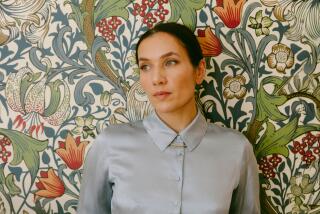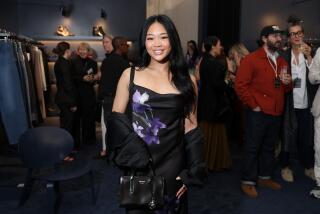The Big Picture
- Share via
At 5 feet, 2 inches, Carolyn Curiel walks tall and dresses “artfully.” For the 42-year-old senior speech writer and special assistant to President Clinton, “it’s all part of the package.” Her clothes--sleek, understated designer suits, jackets and blouses--hover in the 16 to 20 size range.
That she can find pieces with the tailored fit and styling details of the latest ready-to-wear is nothing short of a minor miracle for a boomer-age woman who grew up having to improvise a wardrobe. The past few years have seen the beginning of a large-size revolution as designers and retailers realize that big women don’t covet polyester stretch pants, boxy tunics and pup-tent dresses, but do want stylish, well-made clothes.
And they are buying them. Retail sales of women’s plus-size garments grew 14.2% in 1994 and 6% in 1995, according to New York-based NPD Group Inc., which tracks consumer trends, compared with 6.1% and 1%, respectively, for general women’s apparel.
Among the growing list of designers taking a cut of this burgeoning market are such recognizable and respected names as Ellen Tracy, Emanuel Ungaro (under the label Emanuel), Dana Buchman, MaxMara (Marina Rinaldi), David Dart, Carole Little, Liz Claiborne (Elizabeth) and Tamotsu.
With a few notable exceptions, department stores are moving these lines literally out of the basement and into prime real estate. Even if they’re motivated by big bucks, not altruism, plus-size women are breathing a collective sigh of relief.
Says Janey Milstead, editor in chief of Los Angeles-based BBW magazine (Big Beautiful Woman): “We’re everything--we’re nuclear physicists and cabdrivers. We’re not eating Oreos under the bed with a veil drawn between us and the world. This is an available market. . . . But we’re not used to being able to shop. When I was growing up I bought grandma dresses and ripped them apart and made a vest and skirt out of them. Now I can go shopping.”
And she is just one among millions. Despite the country’s allegiance to Jenny Craig, StairMasters and SnackWells, statistics point to the fact that we’re packing on the pounds. Ms. Average American stands 5-feet, 4-inches tall and weighs 144 pounds, putting her in a size 12. More than one-third of American women are overweight, according to National Center for Health Statistics.
Even such upscale stores as Saks Fifth Avenue acknowledge this shift. Five years ago the chain added plus sizes in Salon Z, which in some stores (including Beverly Hills) occupies an entire floor.
“We could see there was a need,” says Lynne Ronon, Saks’ senior vice president. “The [large-size] customer was buying her cosmetics and accessories here, why not apparel?”
Macy’s has expanded its plus-size division, occasionally breaking out into free-standing Macy’s Woman stores, including one in Century City.
“Ten years ago, the customer took what she got,” says Ginny Peterson, Macy’s divisional merchandise manager for special sizes. “Now she’s excited to find things, and she’ll buy the product as soon as it hits the floor.”
But not everyone feels compelled to serve the large-size market. At Barneys New York in Beverly Hills, customers won’t find any size above 16. “What we try to do is encompass petite and large sizes within the collections we buy, or find collections that are suited for customers on the large size,” explains Bonnie Pressman, executive vice president of women’s fashion. “We think our customer likes to shop our total store and be able to find sizes that fit within the lines we carry.”
Indeed, the revolution has stopped well short of a complete turn-around; no one’s holding her breath waiting for a large-size model to grace the cover of Vogue. More often than not, petite sizes get better placement in stores, and most of the world’s most influential designers won’t deign to do a plus line.
While the Ford Models 12+ division has some 50 women on its roster, including such stars as Emme (one of People magazine’s 50 Most Beautiful People), the bulk of their editorial work comes from Europe. America has been slow in changing its attitude toward large women.
Says Suzanne Donovan, executive director of the agency’s promotion and development, “Unfortunately these moguls in advertising have a stereotypical idea of American beauty, and in reality the people who manufacture these products are becoming more hip [to the fact] that the consumer is older and larger than she was or has ever been, and she’s willing to spend more money, and the areas of fashion and beauty are growing the most.”
Most fashion magazine editors still won’t cross the line and feature large models interchangeably with slim ones. Christy Haubegger is an exception. The president and publisher of the newly launched New York-based magazine Latina has vowed not to put stick-thin models in her pages.
“Our bathing suit models in the magazine have real curves,” says Haubegger, “and we do plan to cover large-size fashion because we know what the world looks like. I hope this magazine is a place where women really do find themselves. I’m a size 10 or 12 petite, and for a long time stocking size charts did not have me on them. I didn’t exist in the pantyhose world.”
Curiel has been there. The elegant clothing she prefers has been easy to come by only in the last five years, she says. Before that, she sewed her own wardrobe. Having to forage in department store basements was “disgusting and humiliating, and if not for the fact that they had me as a captive audience, they would not have had me at all.”
But now she can wear Tamotsu or Ellen Tracy and other designers whose clothes flatter her figure. As an integral part of Clinton’s camp, she travels extensively and has to be ready to attend a black-tie function or visit the site of a natural disaster.
“I think that as America takes a good, long look in the mirror, and as designers look with them, they realize that that’s where their bread is buttered,” she says. “I feel that the generation coming up now probably won’t have to take to the sewing machine like I did. There should be more options out there.”
L.A.-based designer David Dart added plus sizes to his line about three years ago when he noticed a void of “casual, sophisticated clothing with a twist” for larger women. “Yes, you do lose your great body as you get older, but that customer who was younger and had great taste is older and has the same taste level.”
He found his fluid, roomy, unconstructed separates readily adaptable to large sizes. And he learned to break the rules.
“Sometimes it’s like, not that tunic again! I try to move forward. Supposedly, white [skirts and pants] never sold. So when we did it, what was the first thing to sell out? White bottoms.”
*
On QVC, plus sizes from designers like Susan Graver and Caroline Simonelli are hits with viewers who favor Graver’s mix-and-match sporty separates and Simonelli’s minimalistic, fluid knits. Ellen Alpert, the cable channel’s fashion director, says large sizes account for 20% to 30% of total clothing sales. Plus-size models are always featured, and some of the hosts are on the zaftig side. “I think it just brings more reality to the way we show fashion.”
Celebrities have also helped raise the profile of large-size women. Rosie O’Donnell, Roseanne, Linda Ronstadt, Kathy Bates and Wynonna have changed the way we think about glamour. Former talk show host Carnie Wilson hopes to do more and start her own clothing line: “I want to reach the people who shop at Wal-Mart. . . . [The fashion industry] is in such denial. It’s like giving heroin to an addict. ‘If we give you fat sizes, you’re going to stay fat!’ ”
Delta Burke (a.k.a Suzanne Sugarbaker of “Designing Women”) already has an eponymous collection for sizes 14 to 28 in stores around the country, including JCPenney. Personal appearances often become bonding sessions with customers, proving that body image and clothing are inexorably welded. “When one woman thanked me for giving her her dignity back, it was really moving,” Burke recalls. “I remember that’s how I felt--I wanted my dignity back.”
Burke’s very public weight gain years ago sparked catty comments and tabloid gossip, eventually becoming the subject of a landmark 1989 “Designing Women” episode, “They Shoot Fat Women, Don’t They?”
After coming to terms with her larger self, Burke decided to launch her own clothing line, offering women styles she couldn’t find: floaty dresses in sheer fabrics, tailored suits, short sets and jeans.
“Mainly I was finding big old boxy things,” she recalls. “I’d see cute clothes in a magazine, and [designers] just assume that once you hit a certain size you don’t want to wear anything like that, that you lose your sexuality, your brains and any personality you have. You become a nonentity. I knew these ladies didn’t want that. I can tell it with a different perspective--it’s one of those things that you have to have gone through it.”
*
Idrea Lippman and Wendy Johnsen cater to a trend-loving large-size customer at their 7-year-old Great Changes boutique in Studio City, but admit that it’s still tough to maintain their stock of fun, kicky clothes.
“My experience has been that 80% of the manufacturers are still playing it safe,” Lippman says.
The plus-size woman “needs to be re-educated,” Lippman adds. “She needs to learn how to take risks in fashion. Boxy jackets, matching outfits--that’s the safe kind of stuff. They say, ‘I’ve never worn a sheer sleeve, I can’t wear a slinky fabric.’ The worst thing that can happen is nothing, and the best thing that can happen is everything.”
Milstead of BBW magazine had trouble pulling together elegant evening clothes for a fashion layout in last season’s romance issue, and had a rough time locating maternity wear for an upcoming motherhood issue.
Still, she admonishes women to speak with their pocketbooks and support the industry that’s giving them better clothes--before resources dry up.
“The clothes do exist,” she says. “But I want more plus-size women to stop complaining and go shopping, and then complain violently if they can’t find what they need. Go to the buyers, develop a relationship where you shop, frequent these places and tell them, ‘I want you to buy me something to wear.’ ”






